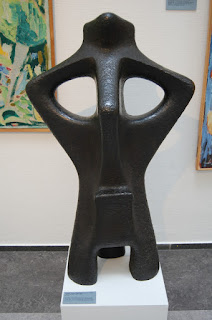Sonja Ferlov Mancoba
As a student in the newly created arts and crafts school class met Sonja Ferlov Mancoba painter (1911-1984) in 1931 Ejler Bille, Richard Mortensen and Gertrud Vasegaard. The following year, she was a student at the Art Academy in Copenhagen.
Sonja Ferlov began her artistic career as a painter and was an early part of the Danish avant-garde, who gathered in the Association line. During a stay at the sisters Lisbeth Munch-Petersen and Gertrud Vasegaard home on Bornholm in 1935 – along with Bille and Mortensen – she made his first sculptures of found branches, which she intuitively put together into three-dimensional shapes. Later that summer she made sculptures in clay. The same year she made her debut on the surrealist Exhibition in Odense.
Sonja Ferlov began her artistic career as a painter and was an early part of the Danish avant-garde, who gathered in the Association line. During a stay at the sisters Lisbeth Munch-Petersen and Gertrud Vasegaard home on Bornholm in 1935 – along with Bille and Mortensen – she made his first sculptures of found branches, which she intuitively put together into three-dimensional shapes. Later that summer she made sculptures in clay. The same year she made her debut on the surrealist Exhibition in Odense.
Sonja Ferlov moved to Paris in 1936 and got a Studio in the same building as Alberto Giacometti, with whom she began a lifelong friendship. She was the liaison between the international art world and the was on the way to introduce a completely new vision of art in Denmark. In 1938, she met her husband, the South African painter Ernest Mancoba.

The post-war years were turbulent for Sonja Ferlov. She appeared in various contexts, also Cobra but she did not participate in the Cobra's exhibitions. Disagreements and misunderstandings between her and artist mates got the family to settle in France, where they isolated themselves for a long time from the art world. There is no identifiable sculptures from this period. In the early 1960s — where she moved back to Paris – she resumed in earnest her artistic work, and created in the years leading up to her death in a large number of major works.
Sonja Ferlov had roots in surrealism. She worked intuitively with his sculptures: they were created directly, without sketches and in dialogue with the material. Her working process was slow, careful and extremely self-critical. She worked the sculptures again and again, as often to destroy the finished work, because it did not meet the strict requirements, she asked to himself. It is one of the reasons that are known only approximately 110 different sculptures from her hand.
Sonja Ferlov was especially influenced by African art. The she had already come to know as a child through the parents ' friend Carl Kjersmeier, who had the largest collection of African figurines and masks. It was Sonja Ferlov, who in the middle of the 1930s introduced his artist colleagues to African art. Alien cultures were seen as immediate and sand art. Mask motif appears in her sculptures from 1938.
Sonja Ferlov thought as her artist colleagues that art could help to change the world by conveying values such as trust, equality, tolerance and humanity. She believed it was the artist's task to establish a link between the art world and the political and social world, in the same way as the shaman in so-called primitive religions creates a connection between the spirits and man








Ingen kommentarer:
Send en kommentar